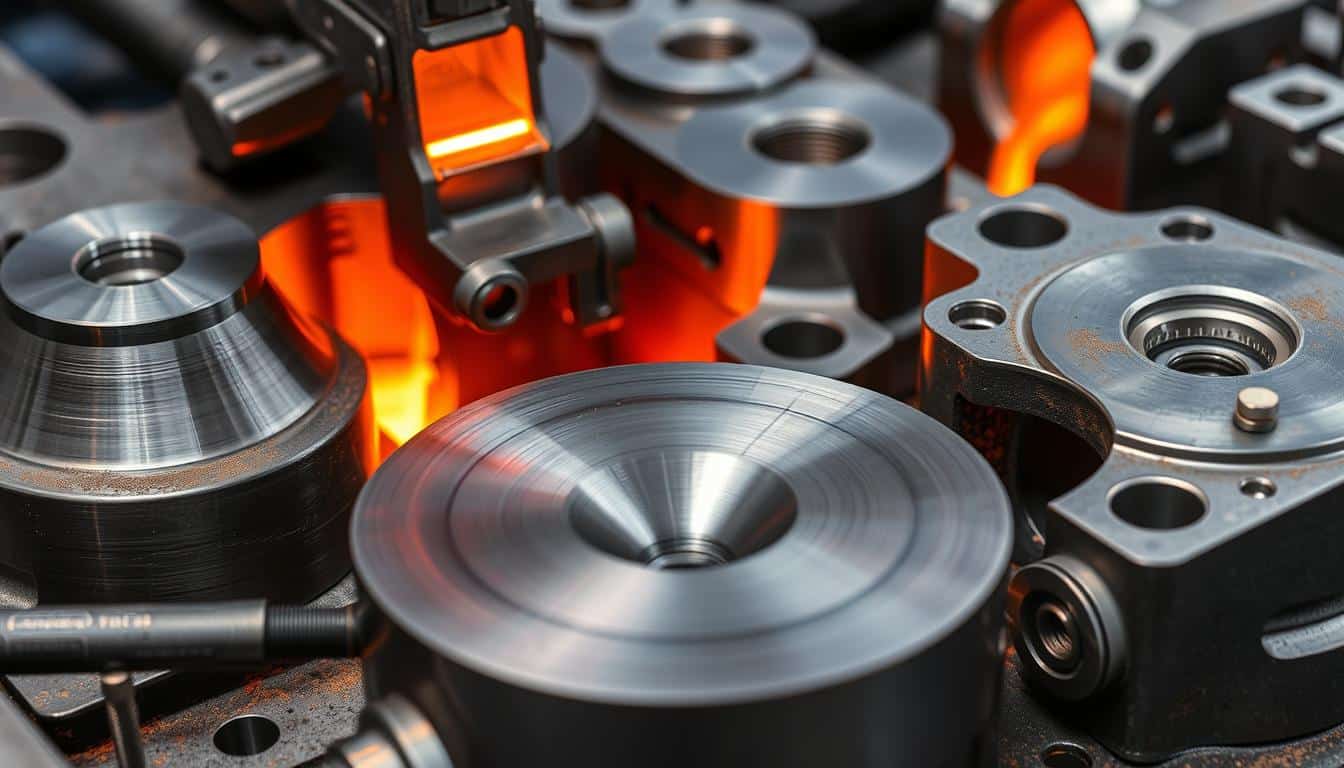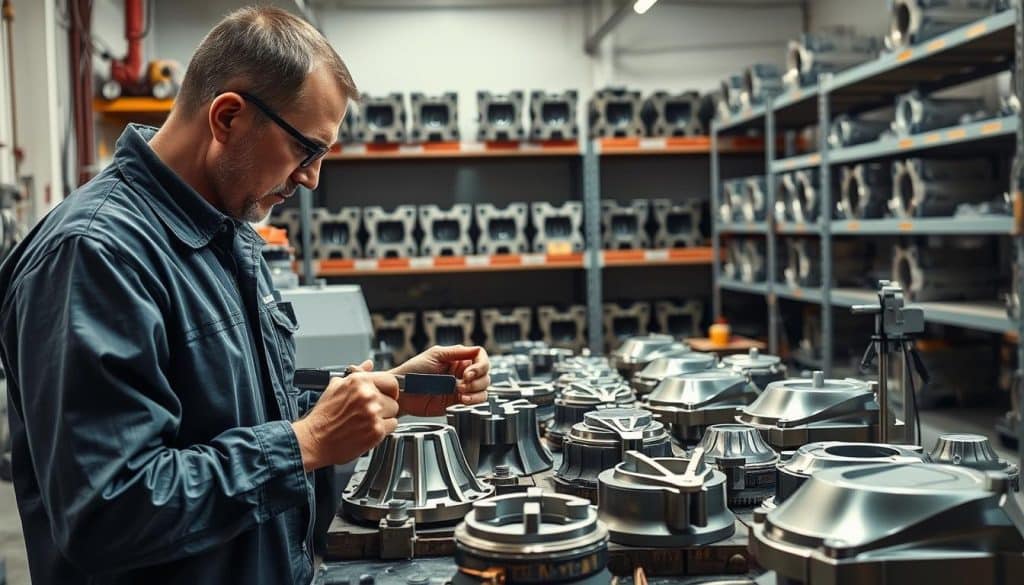Have you heard about investment casting? It’s a method over 5,000 years old, still vital today, especially in high-precision industries like aerospace and defense1. This age-old technique stands out by delivering exceptional accuracy, complex designs, and superior surface finishes1. It’s a favorite in aerospace for crafting detailed gas turbine components, showcasing its vast potential and versatility2.
Investment casting has evolved over the centuries, becoming a key player in metal casting innovation. It’s used to create parts for medical MRI machines2, and automotive construction gear2, showing its wide-reaching applications. This guide dives into the history, processes, and material choices of investment casting, helping you to leverage its benefits for your projects.
Key Takeaways
- Investment casting remains relevant after over 5,000 years of innovation1.
- Extensively used in industries such as aerospace, automotive, and medical sectors for high-precision parts2.
- Offers high dimensional accuracy, smooth surface finishes, and design complexity1.
- Perfect for producing components requiring strength and repeatability1.
- Modern applications include gas turbines, MRI machine parts, and construction equipment2.
What is Investment Casting?
The investment casting process, or precision casting, turns complex designs into real, high-accuracy parts. It is chosen often for making metal components in many industries. Let’s explore its basics, history, and modern uses.
Introduction to Investment Casting
Investment casting is known for producing very precise parts from various materials. It works with almost any alloy, offering flexibility for many uses3. The method can handle parts ranging from a few ounces to over 1,000 pounds3. It’s great for making thin walls and complex shapes4.
Historical Background of Investment Casting
Lost wax casting has been trusted for over 5,500 years4. Early civilizations made jewelry, idols, and ceremonial items with it. Its long history leads to today’s investment casting, which uses advanced tech for better results. The process includes dipping ceramic shells and heating them to about 1000°C (1832°F)4.
Modern Applications of Investment Casting
Nowadays, investment casting is key in many fields. Aerospace, military, and automotive industries depend on its accuracy and reliability4. It’s ideal for parts needing high melting points and smooth surfaces, achieving about 125 RMS4. The method also allows for complex internal shapes and close tolerances, saving on follow-up costs3.
Investment casting is time and cost-effective. It uses resources well and is more repeatable than traditional methods4. This is why it’s a favored way to make quality parts in many demanding industries.
Learn more about investment casting and its benefits by visiting this page: investment property.
The Investment Casting Process Explained
Investment casting makes precise parts with great detail. It involves using a wax pattern that’s eventually replaced by molten metal. We’ll look closely at each step, the materials, and the techniques used in this process.
Step-by-Step Guide
Below are the key steps in investment casting:
- Creating the Die/Pattern: A wax model is made using a die. This model is an exact copy of the final piece.
- Mounting the Wax Patterns: Wax patterns are fixed to a wax stick, forming a “tree assembly.” This is like preparing parts for a new board game5.
- Shell Molding: The assembly gets dipped in ceramic slurry and sand to create a strong shell. This process is repeated to ensure the mold is durable5.
- Wax Removal: The wax is melted away, leaving a hollow ceramic shell. This can be done by heating or using steam. Burning is another method to remove any remaining wax5.
- Mold Casting: The shell, now empty of wax, is heated. Then, molten metal is poured in to form the part.
- Removing the Shelled Casting: After the metal hardens, the ceramic shell is removed to show the unfinished cast.
- Finishing Operations: The casting is then refined through sanding, coating, or machining. These steps remove flaws and improve the surface5.
Materials Used in Investment Casting
Investment casting uses many materials, like steel, nickel, and cobalt alloys. Silica sol and water glass are key materials. Silica sol ensures better surfaces but costs more. Water glass is more economical. Silicon, zircon, and alumina are among the refractory materials used6.
Common Techniques and Methods
Many techniques improve investment casting. Vacuum and tilt casting, along with pressure-assisted pouring and centrifugal casting, enhance mold filling and product quality. These methods help achieve smooth surfaces, precise measurements, and the creation of complex parts. They allow casting of tiny pieces to large items weighing several hundred pounds6.
Investment casting has a 5,000-year history. Its long use proves its effectiveness in making detailed and exact parts6. The process’s versatility in materials and techniques makes it crucial for modern manufacturing.
Advantages of Investment Casting Over Other Methods
Investment casting stands out by making complex parts with less waste and a great finish. It’s better for many industries because of this.
Comparison with Sand Casting
Investment casting beats sand casting in many ways. It has tighter tolerances, around CT5-CT6, so less precision machining is needed7. Also, it can achieve smoother surfaces, around 125 micro finishes, which is better than sand casting8.
The process also has a lower rejection rate. This results in higher quality products with fewer flaws7.
It allows for more complex designs not possible with sand casting. It works with a wide variety of materials like carbon steel and aluminum alloy7. The near-net shape capabilities reduce material waste, saving costs7.
Comparison with Die Casting
When we look at die casting next to investment casting, each has its perks. Investment casting provides more design freedom for complex shapes that die casting can’t handle9. It also ensures excellent tolerance control for consistent, high-quality outcomes9.
Moreover, investment casting can use a broader range of metals, including aluminum and bronze, unlike die casting9. Even though die casting might be faster, the precision of investment casting is often more important.
Comparison with Machining
Compared to machining, investment casting cuts down on the needed machining after casting. It hits tight tolerances of 0.003 inches, reducing the need for extra finishing8. This leads to lower costs and quicker part completion.
Moreover, it’s better at making complex shapes directly, cutting down on the labor and setup machining needs. Recycling materials, like wax for patterns, makes it environmentally friendly and cost-effective8.
| Aspect | Investment Casting | Sand Casting | Die Casting | Machining |
|---|---|---|---|---|
| Tolerances | CT5-CT6 | Higher tolerance | Moderate tolerance | High tolerance |
| Surface Finish | 125 micro finish | Rougher finish | Good finish | Fine finish |
| Material Waste | Low | High | Moderate | Varies |
| Design Complexity | High | Low | Moderate | Adaptable |
| Material Versatility | Wide range | Limited | Moderate | Various |
Materials Used in Investment Casting
Investment casting stands out because it can use many kinds of materials. These range from common metals to unique alloys. You can find carbon steel, stainless steel, titanium, and materials that resist high heat. This makes it possible to create strong parts that meet specific needs.
Stainless steel casting is getting more popular for things like car parts and golf clubs. That’s because it’s very tough and doesn’t rust easily1011. EPCO offers a variety of stainless steel types, including 17-4 PH, 15-5 PH, and both 300 and 400 series. This means they can fulfill many different requirements12.
Titanium investment casting is very important for fields that need light but strong materials and good corrosion resistance. This includes aerospace and medical fields. Nickel and cobalt alloys are also used a lot because they can handle high temperatures and don’t corrode easily. These materials are great for industries like oil and gas and aerospace1112.
Aluminum alloy is often used in investment casting, especially in aerospace and military. It’s known for its strength and flexibility10. Carbon steel is another material that’s widely used because it’s not expensive. It works well in industrial settings due to its heat-treatable nature. This makes it a good choice for important parts in transportation1011.
Copper-based alloys are chosen for their resistance to corrosion and low wear. They’re perfect for things like ship propellers and electrical parts1011. Bronze and brass are good for making items like impellers and door handles because they’re easy to shape and resist corrosion11. Using special alloys like Inconel and Monel allows for even more unique components in fields like fluid power and aerospace11.
EPCO works with over 75 types of metals for precise casting. This gives customers many options to meet their needs12. They also provide more than 400 types of copper alloy. This shows how flexible investment casting can be to match design and performance requirements1011.
Flexibility in Design with Investment Casting
Investment casting is known for its exceptional flexibility in design. It’s perfect for intricate structures and detailed parts. This method lets us create parts of many shapes and sizes. This wide-ranging appeal benefits multiple industries.
Complex Shapes and Sizes
Investment casting specializes in complex shapes with high precision. Parts can be tiny or huge, from 0.1kg to 100kg. This versatility is suitable for various applications13.
It can handle detailed designs and create parts with tight accuracies, between +/-0.010’’ and +/-0.004’’13. Also, this technique can achieve excellent surface finishes. This usually cuts down the need for extra finishing13.
Customizable Material Choices
Investment casting also allows for different material choices. You can pick from a wide range of alloys to meet specific project needs. This adaptability ensures it fits various mechanical and environment needs. It’s especially useful in high-precision fields like aerospace and the medical industry.
Industries Benefiting from Investment Casting
Investment casting is key in many industries, thanks to its accuracy, dependability, and versatility. It’s especially useful in aerospace, medicine, and defense. These fields need parts that are both high-quality and durable.
Aerospace Industry
For aerospace, investment casting is vital. It helps make precise parts for aircraft interiors and exteriors. Things like turbine blades and engine parts are made with this method14. It ensures aircraft components can handle the rigors of flying and high conditions.
Medical Industry
The medical sector relies heavily on investment casting. It’s used to make top-notch, safety-approved medical devices and implants. As health spending in the U.S. went up to USD 4.1 trillion in 202015, the need for reliable medical castings has increased. This rise highlights the sector’s investment in casting tech to make bio-friendly, strong components.
Defense Sector
Defense manufacturing benefits greatly from investment casting. It’s crucial for making complex, durable parts for harsh conditions. The aerospace & defense industry’s revenue was over 62.0% in the U.S. in 202215. With the global casting market projected to hit USD 24.52 billion by 203015, precision in defense manufacturing is key. This method is used for vital components like weapons, surveillance gear, and aerospace parts for defense, meeting strict military specs.
Tight Tolerances and Precision
Investment casting is known for achieving very tight tolerances. These are crucial for making high-quality metal components that meet design needs exactly. This reduces the need for extra machining, making production smoother and keeping quality high.
Thanks to new techniques, it’s now possible to create gear teeth with tight tolerances right from casting. This might remove the need for hobbing16. Such advances save time and cut costs, boosting efficiency and reducing what it costs to make things16. For example, Shelmet Precision Casting has innovated to achieve tight tolerances for complex parts made in one go16. This approach is great not just for gears, but for parts in industries like cars, energy, medicine, and aerospace16.
Speaking of linear tolerances, R2 Quality Castings can make parts within a tolerance of up to 1” plus or minus .010”17. For bigger dimensions, they adjust the tolerances. This ensures parts are made right, reducing vibrations and keeping machines working smoothly17. Also, they can keep hole diameters within +/- .003” for holes up to ½ inch. This makes sure parts fit perfectly without extra work17.
Investment casting also manages dimensional tolerances well, like (+/-) .10” for dimensions up to 1”17. With varying tolerances for bigger sizes, it makes sure each part keeps the high quality needed.
For more on achieving tight tolerances with investment casting, check out this detailed guide. It explains the processes and tactics used16.
Superior Surface Finish in Investment Casting
Investment casting is well-known for creating parts with a smooth surface. This brings many benefits to different fields. Better looks, less need for extra work after casting, and stronger parts are among these benefits.
Benefits of a Smooth Finish
Investment casting stands out for its quality finish on parts. A better surface finish means less extra work needed, saving time and money18. For instance, parts with a 125 μin (3.2 μm Ra) surface finish need hardly any extra finishing, similar to what milling achieves19.
This smoothness also makes painting easier and requires less prep for plating. This simplifies the whole making process19.
How Surface Finish is Achieved
The process to get a smooth surface in investment casting involves several careful steps. It starts with a wax pattern. This is then covered in ceramic. After the ceramic shell gets hard, the wax is melted off. What’s left is a detailed mold. Molten metal is poured into this mold to make the final part20.
Afterward, steps like vibratory finishing, heat treating, and polishing can make the surface even better20. These steps lead to a finish ranging from 60 – 200 μin, much smoother than other methods like sand casting19.
This excellent surface finish meets both looks and function needs. It also enhances the part’s performance. Thus, investment casting is the top choice for complex shapes and high-quality finishes1820.
Reduction in Machining Requirements
Investment casting excellently achieves near-net shape, which lowers the need for extra machining. Components come out almost finished, saving on material and labor. This is great for precision-heavy industries like aerospace, where durable parts are critical21. It saves resources and cuts down on production time.
Investment casting allows for designing flexible, single-piece castings from multiple parts. This reduces time to completion, waste, and costs21. Casting tolerances are typically within ±0.01 inch for the first inch and ±0.005 inches after that21. Such precision ensures components meet strict requirements without much extra work.
- Investment casting can produce components from tiny sizes to over 1,000 lbs22.
- Near-net shape casting achieves tight tolerances, cutting down on machining22.
- This method allows for casting in various alloys, some unmachineable otherwise22.
- Investment casting generally requires less machining than sand casting or welding does21.
The ceramics in investment casting create superior surface finishes, up to a 125 microfinish22. This means smoother surfaces with less machining needed, improving production efficiency. Investment casting can handle different component weights with excellent finish quality. It offers cost savings while achieving precision demands.
| Advantages | Details |
|---|---|
| Near-Net-Shape Casting | Cuts down on the need for heavy machining, saving materials and labor21. |
| Design Flexibility | Turns multi-piece designs into single castings, reducing waste and expense21. |
| Precision Tolerances | Holds tight tolerances of ±0.01 inches for the first inch and ±0.005 inches after21. |
| Superior Surface Finish | Reaches a high-quality 125 microfinish, lessening the need for post-casting machining22. |
Investment Casting: Cost-Effectiveness
Investment casting is known for its cost-saving techniques. This method impresses with its detailed and precise outputs. It stands out financially, hosting over 150 foundries in the U.S. Consequently, about $12 billion worth of castings are made each year23.
Material and Energy Efficiency
Investment casting shines in using materials and energy well. It allows engineers to add complex details easily and choose metals that make parts stronger23. For example, switching an Inconel impeller from machining to casting cuts costs by 45% and reduces time needed by 40%23.
Lower Machinery Costs
Initially, investment casting may seem pricey due to tooling expenses. Yet, it has lower costs for tool upkeep and storage24. It becomes cost-effective for big orders thanks to less machining after casting and faster completion times24. Turning to casting from other methods saves labor, cuts production time, and makes parts last longer, proving its efficiency23.
Environmental Benefits of Investment Casting
Investment casting is known for its green approach, especially its eco-friendly process and little waste. Its accuracy is praised, leading to high-quality products without the need for extra steps. This results in less material wasted, which is good for the environment25.
This method is great at saving energy. In 1997, the U.S. sector used between 200 and 250 trillion BTUs. Most energy is used in melting, then mold making, and a bit in post-casting26. By making these steps more efficient, investment casting can cut down on energy use.
Investment casting also saves materials. It often doesn’t need extra machining, meaning it uses fewer raw materials than other methods25. This saves not only resources but also reduces the carbon footprint from manufacturing.
| Process Stage | Energy Consumption % | Environmental Impact |
|---|---|---|
| Melting | 55% | High Energy Usage |
| Mold Making and Processing | 20% | Moderate Energy Usage |
| Post-Casting Processes | 7% | Low Energy Usage |
Investment casting reduces the need for much machining. This lowers both the amount of materials and energy used. It’s a top pick for businesses focused on eco-friendly practices25.
The freedom in design with investment casting is amazing. It’s perfect for complex parts used in industries like aerospace and medical25. Being able to make detailed shapes easily also plays a big part in its environmental kindness.
In conclusion, investment casting offers great advantages like saving energy and materials, providing design freedom, and needing less machining. These benefits make it a strong option for sustainable metal production. By choosing investment casting, makers can reach their green goals while still making top-quality products.
Quality Control in Investment Casting
Effective investment casting is all about keeping quality high at every step. By using top-notch inspection methods and working to lessen defects, makers can deliver the best parts to their clients.
Inspection Techniques
Engineered Precision Casting Co., Inc. sticks to strict quality rules. They are AS9100 certified and follow ISO 9001, which means their casting materials are top-quality, without flaws, and match all size needs for reliable quality27. They use a broad range of inspection tools like Vernier caliper, Coordinate Measuring Machine (CMM), Height gauge, and Thread Gauge28. They check everything from wax to the physical and chemical aspects, use spectrographic analysis, mechanical tests, and check for corrosion28.
The company also provides non-harmful testing services. They use liquid penetrant inspection, magnetic particle inspection, and radiography, sticking to standards like AC711427. They also employ dimensional inspection with precise tools and a CMM to assure product exactness and dependability28.
Minimizing Defects
Keeping defects low is key for top-quality investment casting. The foundry uses a thorough quality control process. This includes having three people do on-site, random, and final checks to ensure top-quality control of the casting process28. They test each alloy melt chemically using a spectrometer to meet ASTM and AMS standards28. The firm also shows its dedication to quality with its NADCAP accreditation in Aerospace Quality System, Nondestructive Testing, Welding, Heat Treating, and Hardness Testing operations27.
Through heavy investment in QC abilities and certifications, companies like Engineered Precision Casting Co., Inc. focus on reducing defects in their casting processes. This ensures clients get parts that not only meet but go beyond their quality expectations27.
Limitations of Investment Casting
Investment casting has its share of limits, important to note for projects and production needs. This method provides high precision and detailed designs. Yet, it has limitations you should know before starting your casting projects.
Size and Weight Limits
Investment casting shines in making small, complex pieces. But, it’s not the best for big parts. Making large objects is time-taking and expensive in this method. For bigger projects, sand casting is often better. It’s more flexible and has cheaper mold costs but may lack in accuracy29.
Cost Factors for Small Batches
The cost of investment casting can be high, especially for smaller orders. The upfront costs for wax patterns, ceramic layers, and sintering add up quickly. It’s not the cheapest for small quantities30. Die casting might be better for producing a lot of items, but still costs more for few pieces due to mold expenses31.
Surface Defects and Remedies
Dealing with surface defects is a hurdle in investment casting. Getting the right finish is vital for parts that need little finishing. Luckily, new tech methods are improving how to fix these issues. This enhances investment casting’s quality and use31. Knowing these limits and solutions helps in making smart choices for your manufacturing projects.









